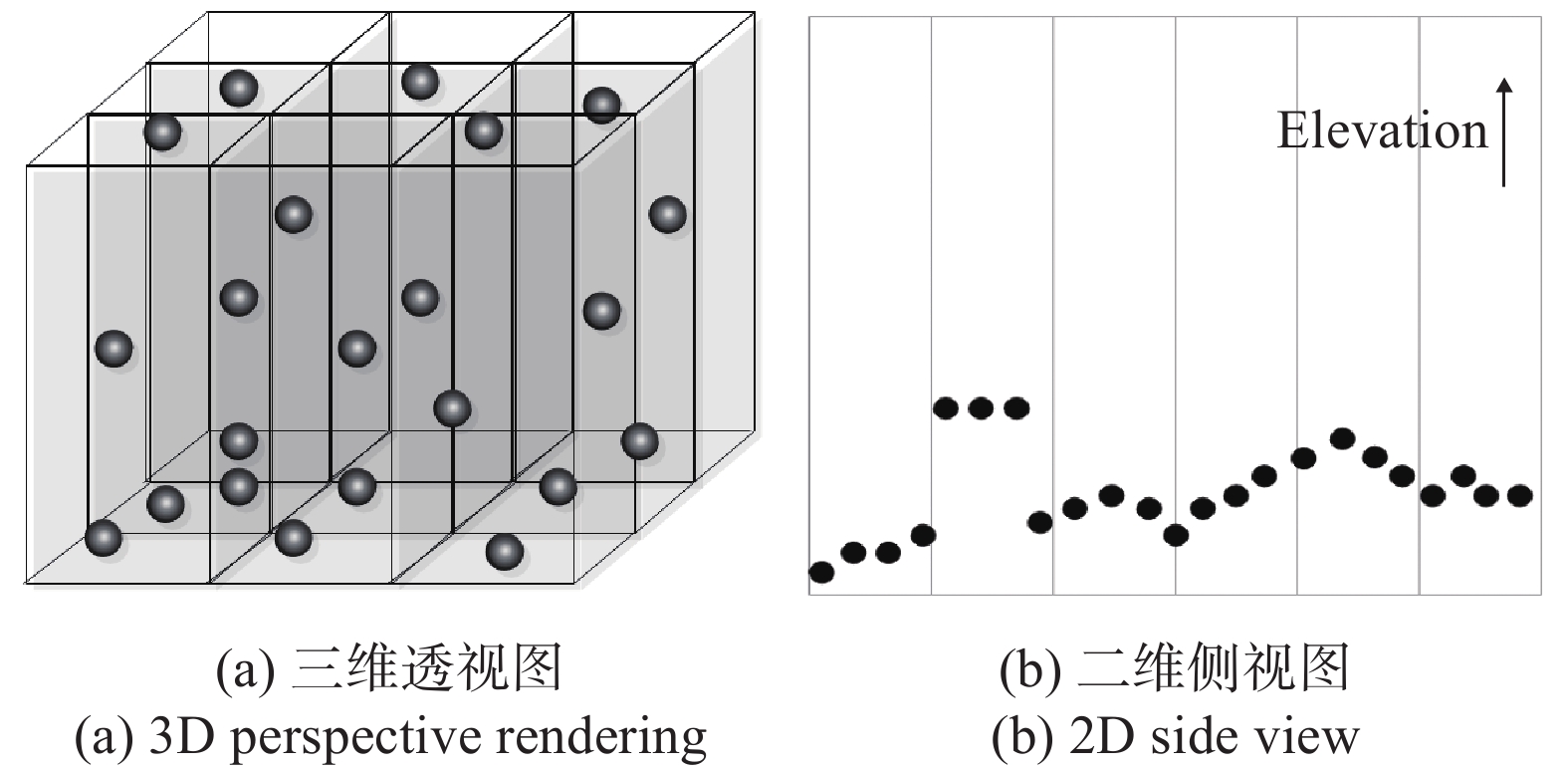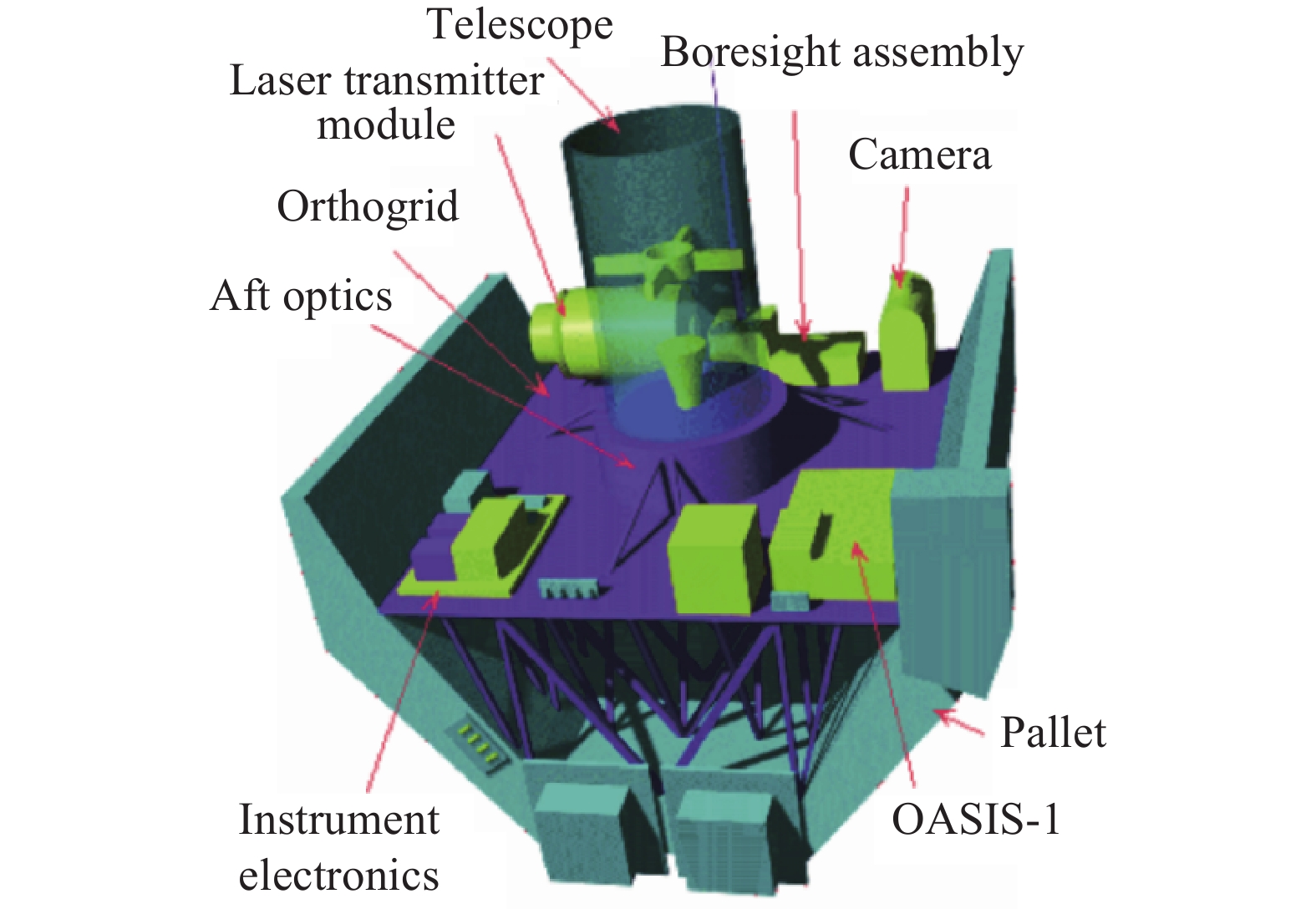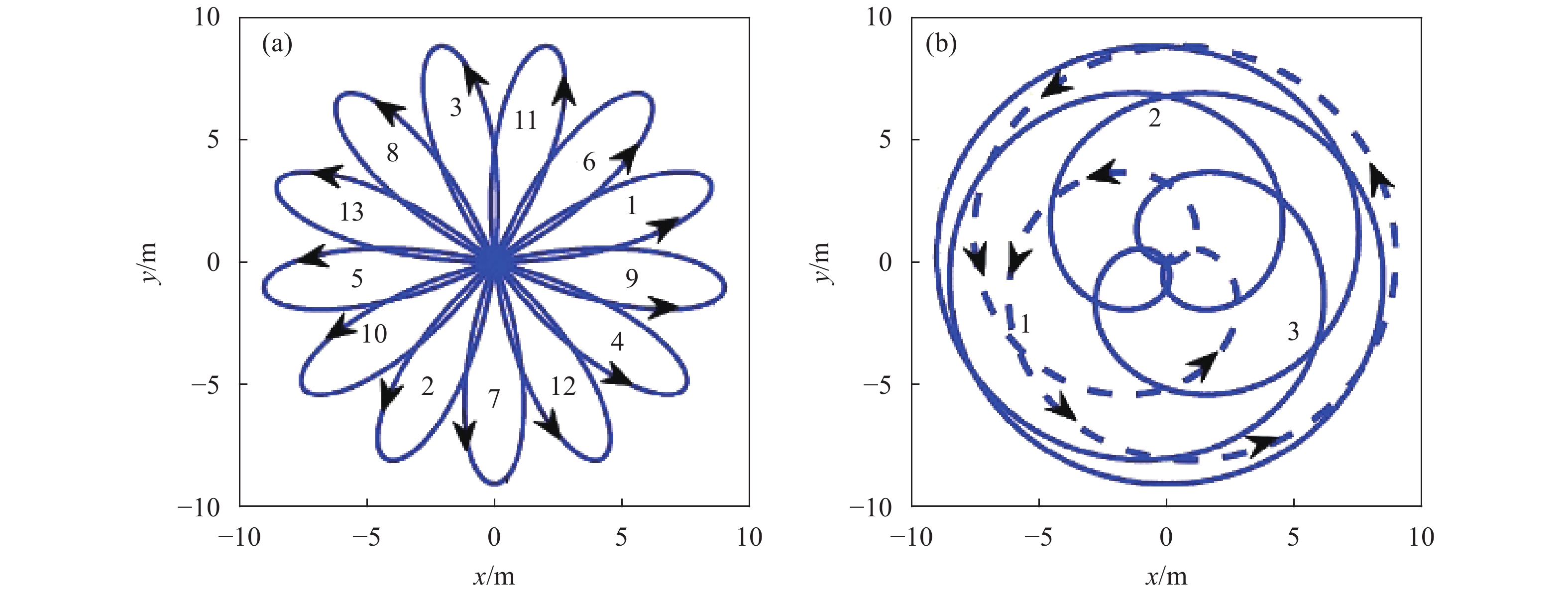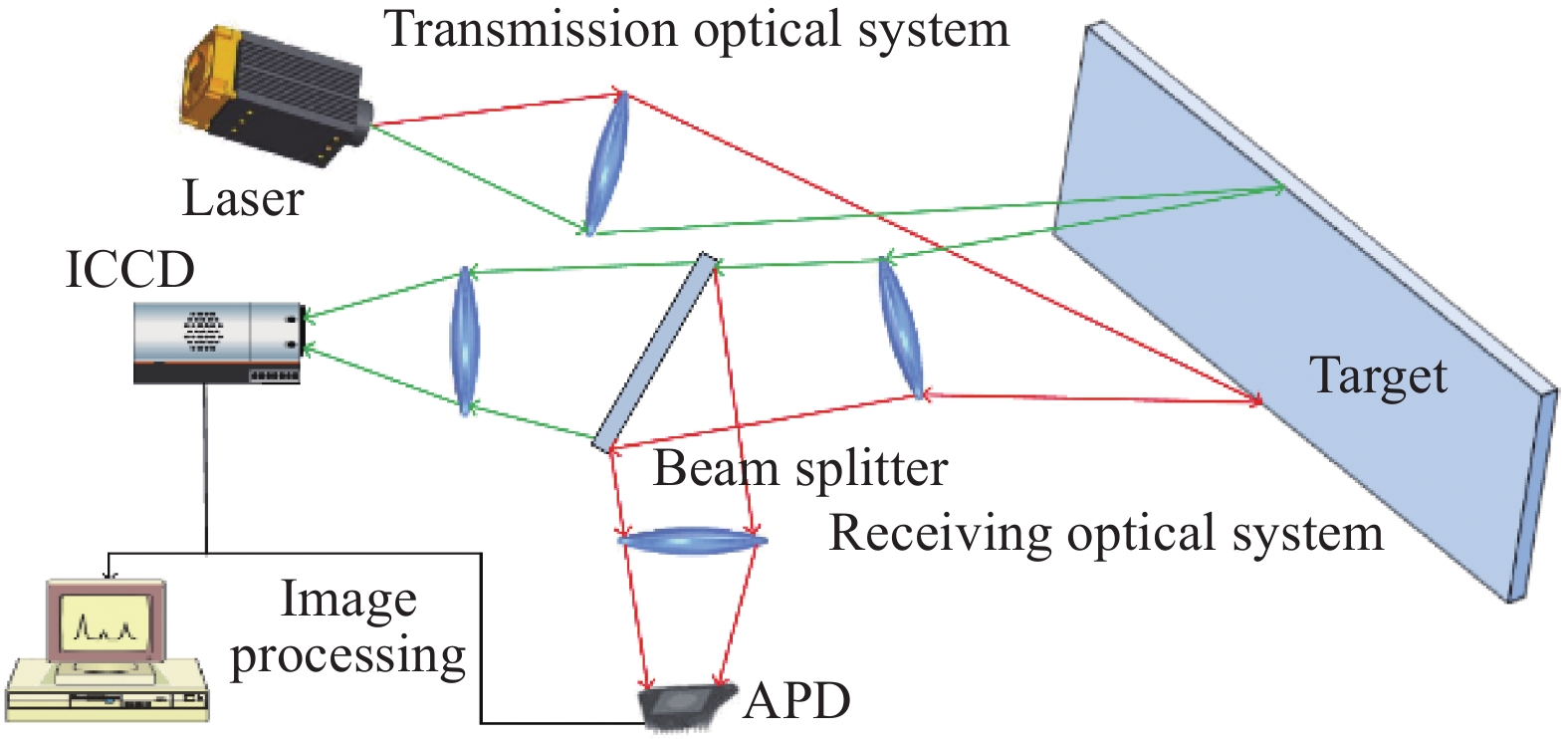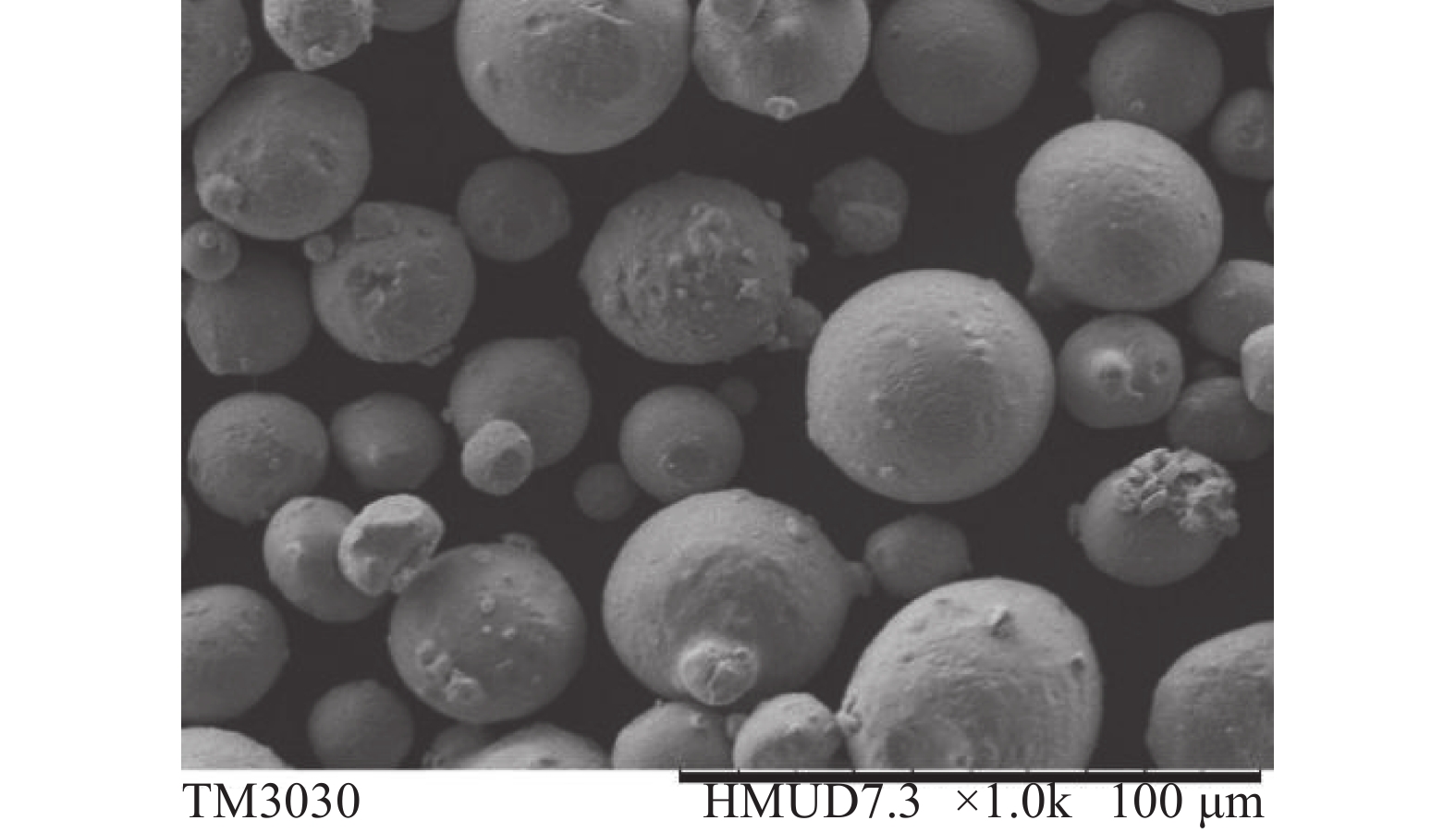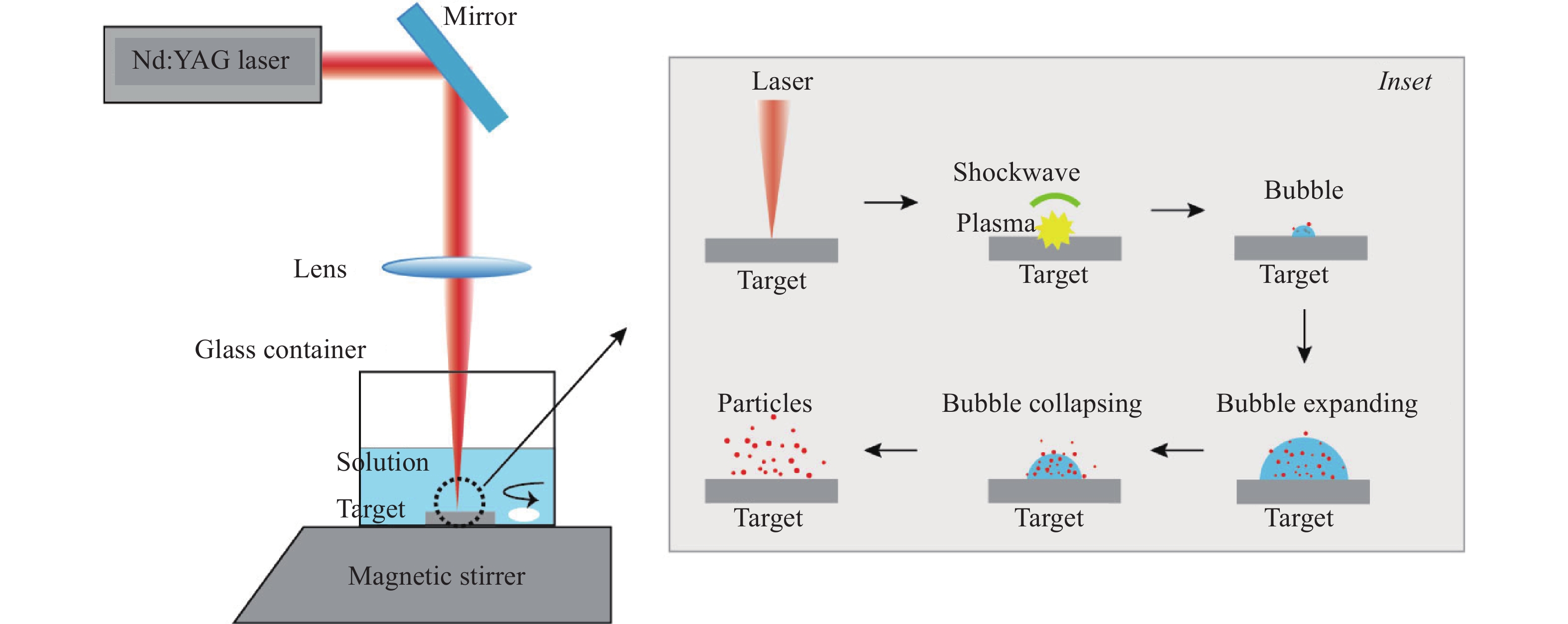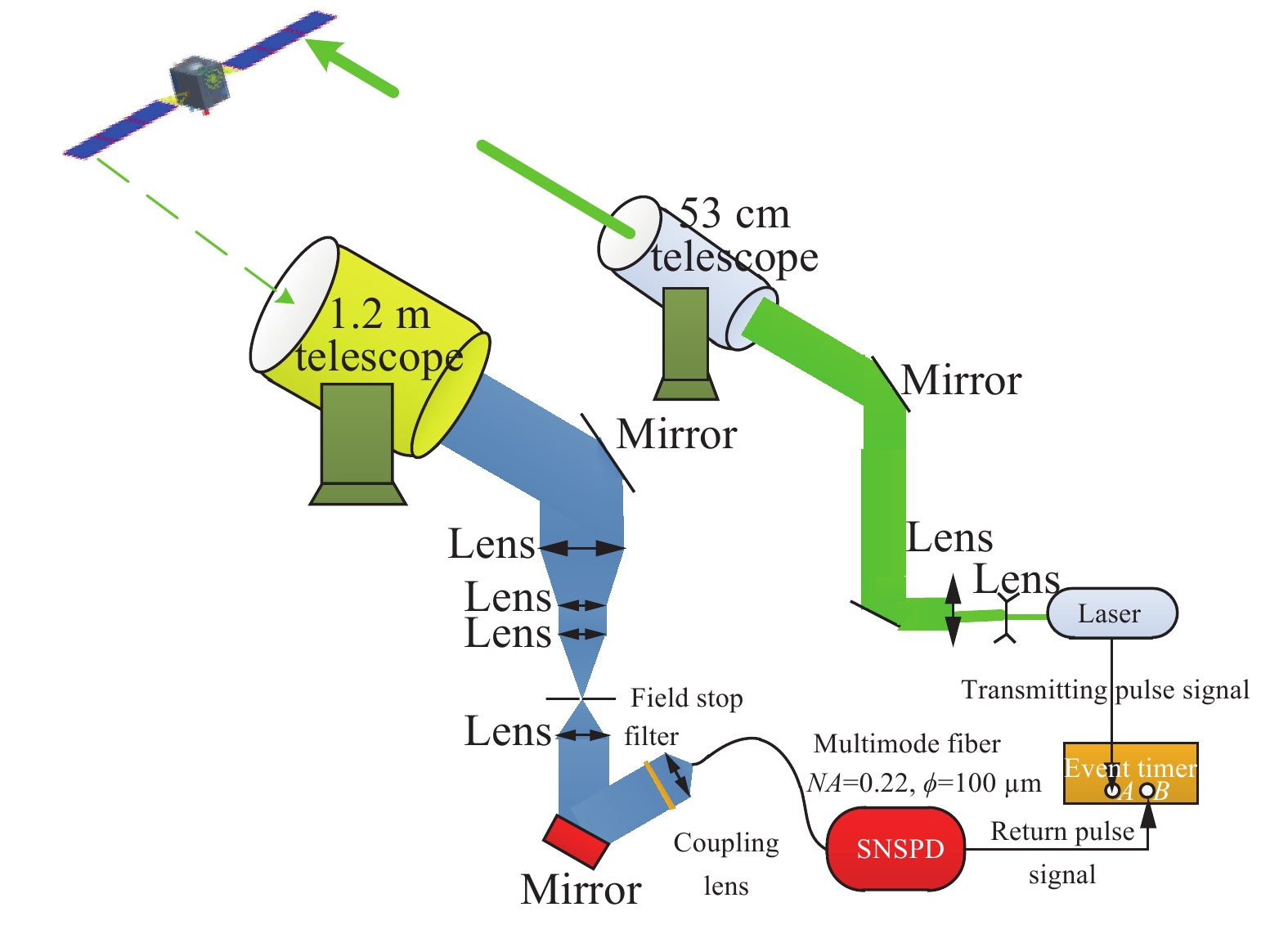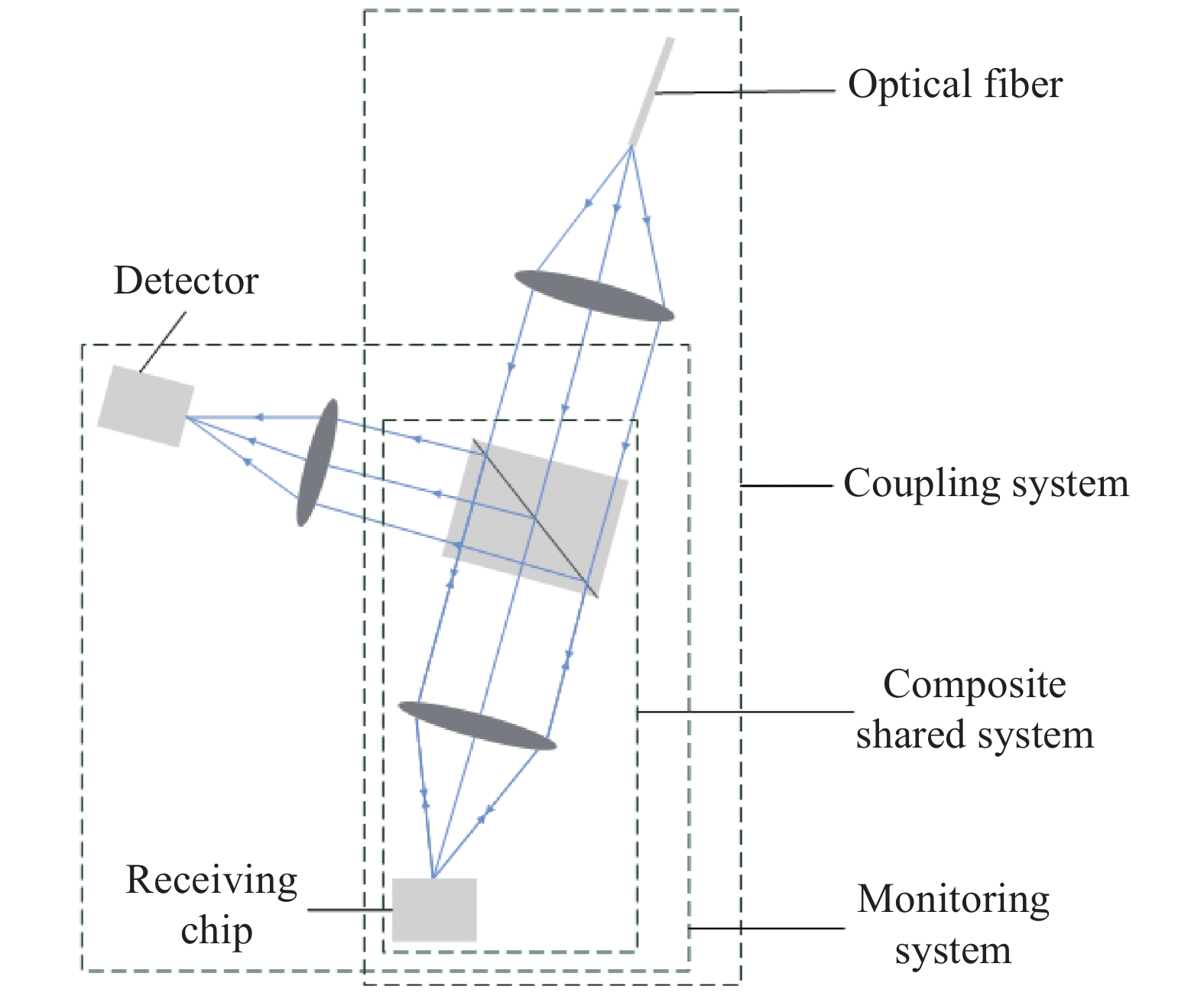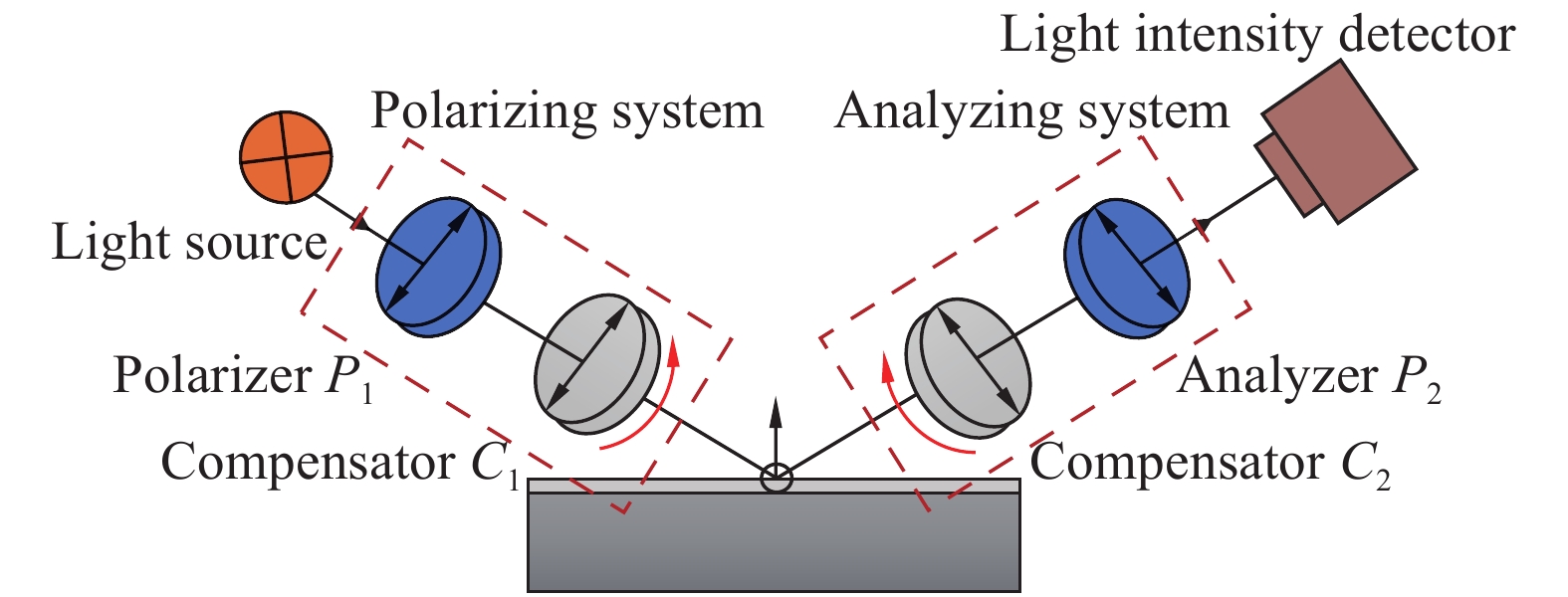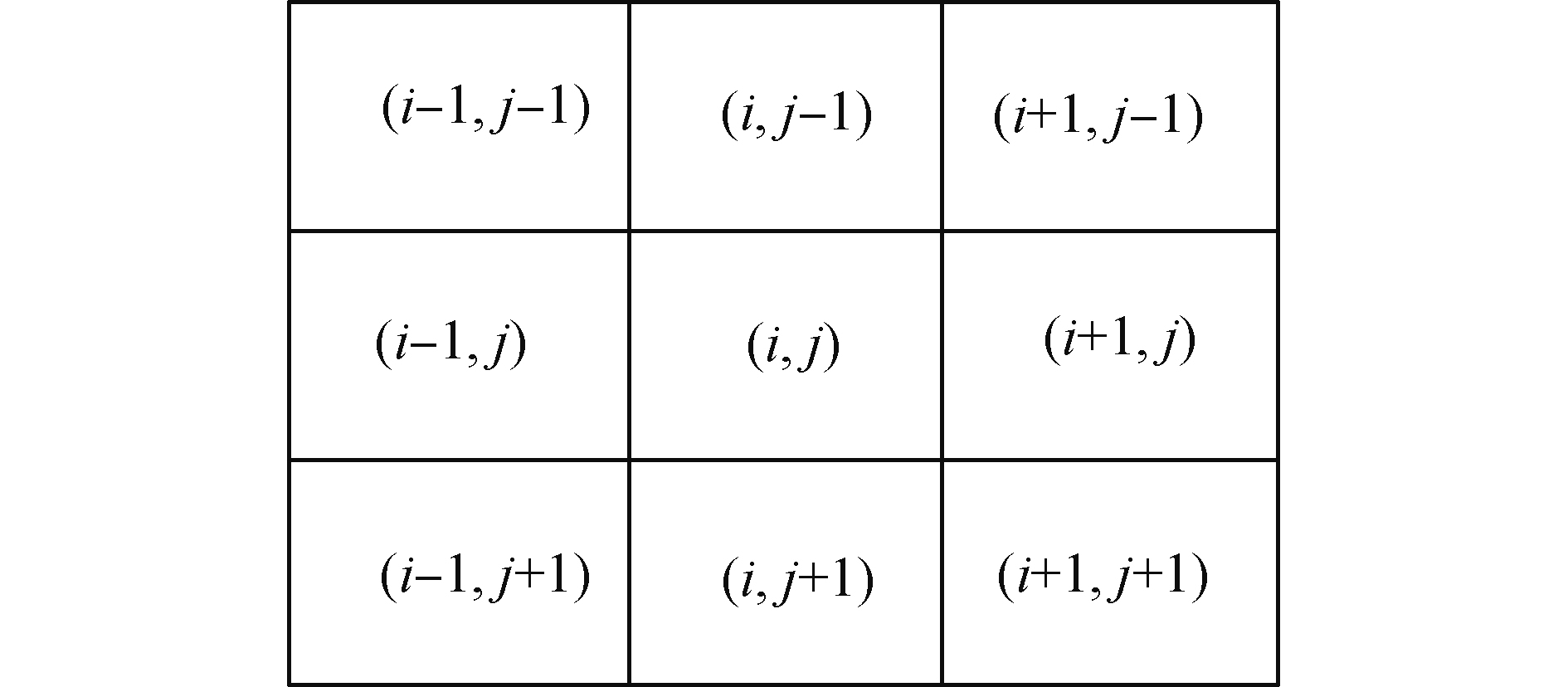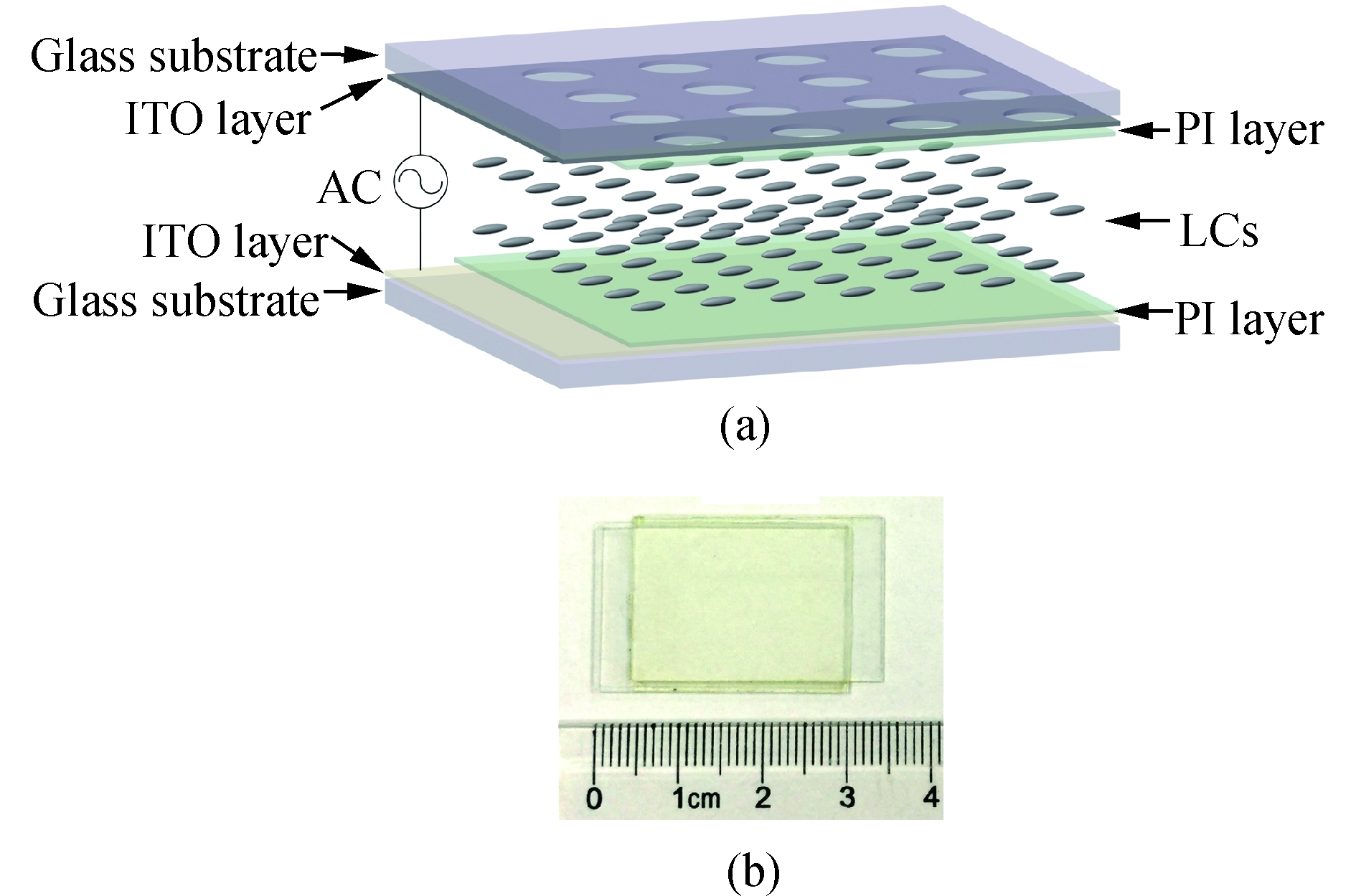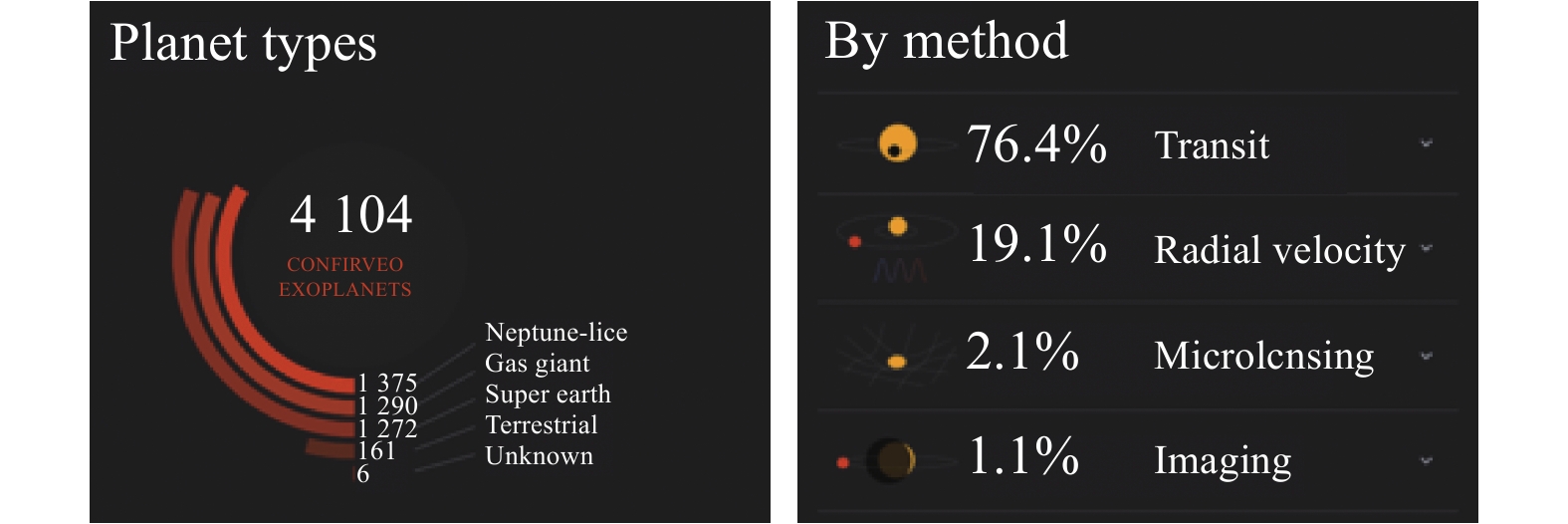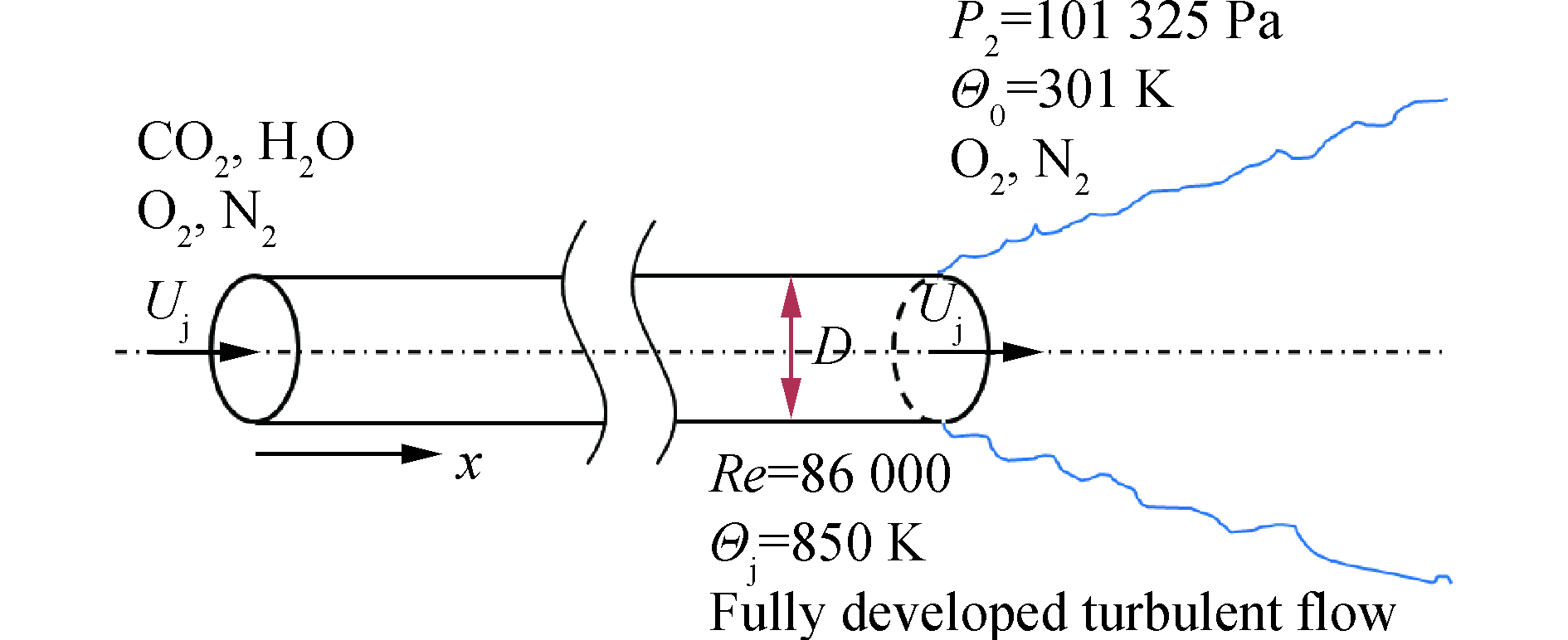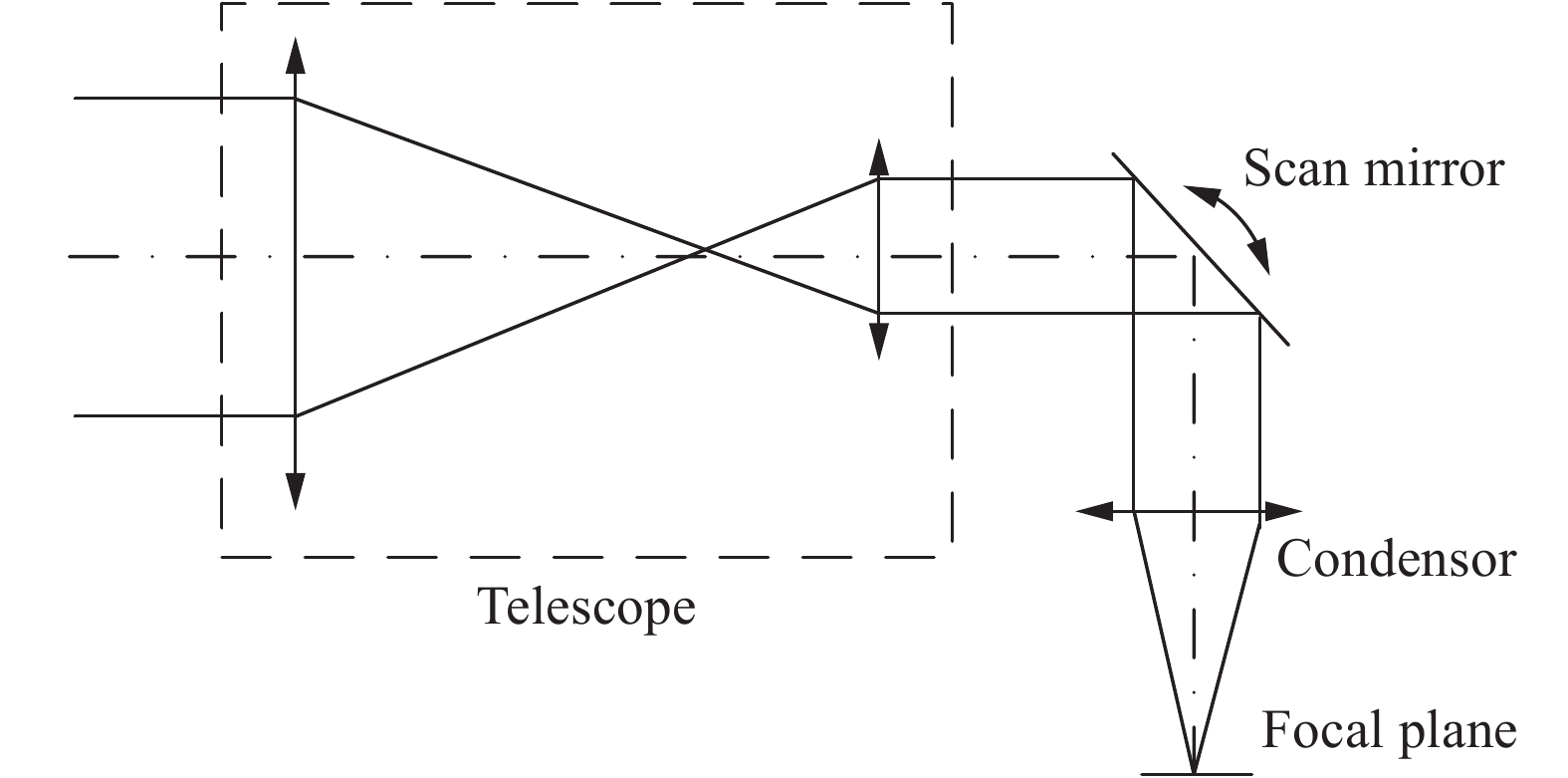2020 Vol. 49, No. 8
2020, 49(8): 20200203.
doi: 10.3788/IRLA20200203
As a large number of abandoned space objects are out of control, they will be in a tumbling state due to the perturbation effects, such as residual angular momentum, light pressure and so on. De-tumbling control of the space objects is probably a safer way before directly capturing them. De-tumbling control techniques for typical space objects at home and abroad was introduced, the concept of de-tumbling by close irradiation of laser with a small spot was proposed, and the main characteristics of laser de-tumbling control were also analyzed. Moreover, based on the pulsed laser ablation impulse coupling effect, the concept of space-based laser de-tumbling analysis was carried out with the typical cylindrical space targets. The results indicate that the laser control method can precisely control the motion posture of the space target. The space-based laser control method proposed in this paper can provide a new method for the de-tumbling control of the spinning space target.
2020, 49(8): 20190439.
doi: 10.3788/IRLA20190439
Point cloud filtering is one of the key steps of airborne LiDAR point data processing. Most traditional methods obtain satisfactory effects just for several specific terrain types. However, ground filtering on the point cloud of complex or mixed terrain types faces a huge challenge. Therefore, a new point cloud filtering method based on grid ground saliency division was proposed. As the point clouds were organized with virtual grid, a ground saliency division based on elevation was performed on the scanning line of point clouds. For different types of grids, different filtering processes were employed to segment point clouds into ground points and non-ground points according to the ground saliency value. Compared with other classical methods, the proposed method avoids the iterative encryption process, and the curved surface was used to fit local terrain in those undulating area, which has better adaptability in complex and mixed terrains with limited increase of computational cost, and generates a set of ground points with high reliability.
2020, 49(8): 20190501.
doi: 10.3788/IRLA20190501
The aerosol radiative forcing effect mainly influences the balance of the Earth’s radiation through two pathways, namely aerosol-radiation interaction (ARI) and aerosol-cloud interaction (ACI). However, uncertainty in ACI is one of the most important uncertainties in the Earth’s radiation factor in the IPCC AR5 report. In the field of aerosol-cloud global detection, the detection capability and development direction of space-borne lidar for cloud-aerosol remote sensing plays an very important role to study the global aerosol-cloud distribution characteristics. Therefore, the application status of space-borne lidar for cloud-aerosol remote sensing was analyzed firstly, and the technical characteristics about the detection task, opto-mechanical system parameters, structure and materials of typical space-borne lidar for aerosol-cloud (LITE、CALIPSO、CATS and ATLID) were focused on. Secondly, the characteristics of each space-borne lidar for aerosol-cloud were compared and analyzed from the aspects of working mechanism, opto-mechanical system structure, applied materials and detection capabilities. The design features and methods of opto-mechanical system of space-borne lidar for aerosol-cloud were proposed. Finally, the technical characteristics and development direction of the current space-borne lidar for aerosol-cloud were analyzed. The technical direction and development suggestions for the development of space-borne lidar for cloud-aerosol were proposed in China.
2020, 49(8): 20190508.
doi: 10.3788/IRLA20190508
Risley prisms in laser 3D imaging radar can effectively reduce the size and weight of the system, which have the advantages of low energy consumption, high precision, and vibration insensitivity. However, the scanning trajectory is complicated, and there is a large amount of redundancy in the scanning points. Firstly, the distribution law of scanning trajectories was studied based on the first-order approximation formula. The variation characteristics of the distance between the scanning trajectories and the distance between the discrete scanning points were then analyzed. Finally, the system scanning parameters for full field of view coverage were obtained. The results show that when full field of view is covered, the counter-rotation and co-rotation have the same system scanning parameters and both have the same minimum redundancy 2π and identical scanning parameters except for the direction of rotation. When the effective scanning field of view and resolution are fixed, at specific speed pair, the partial coverage of the counter-rotation can reduce 1/4 of the redundancy and half-period co-rotation can reduce half of the redundancy. The reduction of redundancy means that the imaging frame rate is increased.
2020, 49(8): 20190511.
doi: 10.3788/IRLA20190511
To solve the problem of low resolution of three-dimensional range profile of lidar, a low cost and effective image processing method was used to obtain high resolution three-dimensional range profile. Firstly, according to the characteristics of multi-sensor system, low-resolution Gm-APD lidar and high-resolution ICCD lidar were combined to obtain low-resolution range profile and high-resolution intensity image after registration. Then, an improved image guidance algorithm was proposed to realize super-resolution reconstruction of low-resolution image. Markov random field model was used to define the global energy function, which combined the distance fidelity term with regularization term, and high resolution three-dimensional range profile was obtained by solving the optimization model. By super-resolution reconstruction of simulated image and lidar range profile, the method was validated by objective evaluation indexes of subjective visual effect and image quality. The experimental results show that the method improves the resolution of range profile and protects the edge structure of the image well. It achieves better results than bicubic interpolation, guided filtering and TGV in the evaluation index of no-reference image quality.
2020, 49(8): 20190523.
doi: 10.3788/IRLA20190523
In order to reduce or eliminate the "stress shielding" effect of artificial implants and improve the biocompatibility, mechanical properties of porous structures formed by selective laser melting (SLM) technology need to be studied. Through the preparation of 316L stainless steel body core cubic (BCC) and regular dodecahedron (RD) porous structures, the longitudinal compression test of the molded parts was carried out respectively, and the Gibson-Ashby model was established to predict the elastic modulus value of the porous structure. The effects of porosity, average pore diameter and specific surface area on elastic modulus and compressive strength of porous structures were analyzed by fractal interpolation. The analysis results show that when the porosity of 316L stainless steel porous structure sample is 55.13%-94.74%, the average pore diameter is 1.90-4.22 mm, and the specific surface area is 0.54-4.33, the elastic modulus is 0.375-1.716 GPa, and the compressive strength is 43.19-160.31 MPa. The elastic modulus of human bone was 0.9-1.7 GPa, which meets the requirements of implants. Porosity, average pore diameter and specific surface area have little influence on the elastic modulus and the amplitude of compressive strength of the dodecahedral porous structure, but have greater influence on the body-centered cubic porous structure. The compressive strength of the dodecahedron porous structure is 111.75-160.31 MPa, and the compressive strength of the body centered cubic porous structure is 43.19-158.03 MPa. The performance of the dodecahedron porous structure is better than that of the body centered cubic structure. This paper provides the basis for the research on the preparation of 316L stainless steel porous structure by selective laser melting.
2020, 49(8): 20190533.
doi: 10.3788/IRLA20190533
Sensibility and protective design of single event transient effect for Pulse Width Modulator(PWM) was validated by pulse laser. During test, by changing the energy of the pulse laser and scanning the PWM circuit step by step, the energy threshold of the pulse laser and the sensitive region of PWM induced single event transient effect were determined. By changing the soft start configuration circuit design of PWM, the rationality of the protection circuit design was verified, which provided a technical reference for the single event transient protection design of satellite power subsystems.
2020, 49(8): 20190541.
doi: 10.3788/IRLA20190541
Laser feedback confocal tomography was used for high-resolution surface topography measurement, internal imaging of MEMS devices due to its extremely high sensitivity and longitudinal resolution, and can locate metal foreign objects in biological tissues. However, so far no cell-level imaging of biological tissues has ever been performed. A three-dimensional imaging system based on laser feedback confocal tomography was designed and built. The living tissue was detected and reconstructed, and the structure information of the cells can be clearly observed, which can prove its application value and development potential of technology in the field of biological tissue imaging. The three-dimensional imaging system can obtain a lateral resolution of 1.4 times the diffraction limit. When a microscope objective lens with $NA = 0.42$ was used, the lateral resolution was about 1.1 microns and the longitudinal resolution was 19.4 μm. It was used for surface topography measurement better than 500 nm.At the same time, a 3D positioning and scanning acquisition module based on LabVIEW software and a 3D image reconstruction module based on Matlab software were designed to accurately locate the area to be measured, and then obtain a 3D tomographic image of the area to be measured, which has considerable practical application value.
2020, 49(8): 20190498.
doi: 10.3788/IRLA20190498
Laser ablation in liquid can modify the target morphology, as well as fabricate micro-nano materials in the solution. Many researchers were attracted by this method, because it was chemically clean, low cost and simple operation. Here, germanium particles with micron and submicron scale were prepared by Nd: YAG nanosecond pulsed laser ablation in water. The characteristics of germanium particles were studied by ultraviolet-visible absorption spectrum (uv-vis), X-ray diffraction (XRD) and scanning electron microscope (SEM). Then, studied the target morphology and ablation quality were studued after laser ablation of the germanium target. It was found that the ablation quality increases with the number of laser pulses, but the increase rate decreases, which means the ablation efficiency decreases. Finally, the reasons for the decrease of ablation efficiency were discussed to provide theoretical reference and feasible strategy for improving the preparation rate of materials fabricated by laser ablation in liquid.
2020, 49(8): 20200228.
doi: 10.3788/IRLA20200228
In order to measure the incoming wind information before it reaches a wind turbine, a laser wind measurement system was developed for need of yaw control of wind turbine based on continuous wave coherence detection. A direct drive(DD) motor was installed in the scanner to drive a wedge lens with 15° vertex angle for laser conical scanning in the atmosphere. The scan period is 15 s, and has 30 sampling points. The sinusoidal fitting method was used to retrieve the velocity and direction of the incoming wind field of wind turbine. The laser wind measurement system was installed under the meteorological gradient observation tower in Shenzhen, and a comparative experiment was carried out with the ultrasonic anemometer on the tower. Measured data were compared and the results are as follows: the correlation coefficient of horizontal wind speed was 0.98 and the standard deviation was 0.22 m/s, the correlation coefficient of wind direction data was 0.97 and the standard deviation was 3.04°. It shows that the laser wind measurement system has satisfactory performance and can provide accurate parameters of wind turbine, which is conducive to improve the efficiency of wind energy utilization.
2020, 49(8): 20190536.
doi: 10.3788/IRLA20190536
As a novel single photon detector, the superconducting nanowire single photon detector can work in constant current mode with high sensitivities, low dark counts, and high detecting efficiencies for 1064 nm wavelength laser. Applying the detector to satellites with retroreflectors and space debris without any retroreflector laser ranging experiments in nighttime, a set of good observing data was obtained. To make advantages of this detector in space target laser ranging, the feasibility of employing it to daylight laser ranging system was studied and analyzed through the daytime laser ranging experiment and the actual response output measurement for daytime sky background light. The navigation satellite glonass134 (~20 000 km) and the low-orbit satellite hy2a were measured before sunset; the maximum counts output of the single-photon superconducting detector could reach up to 2 MHz during the actual daytime sky background light measurement. The results show that using the superconducting single photon detector as echo detector can realize a high performance and high efficiency daytime laser ranging system.
2020, 49(8): 20190438.
doi: 10.3788/IRLA20190438
With the increase of precision requirements for manufacturing, processing and assembly of large scale workpieces and equipment, high precision measurement system is needed to measure the machining and assembling process of workpiece. Multilateral laser tracking 3D coordinate measuring system measures the distance data to solve the space point coordinates which can avoid the error caused by the angle measurement of laser tracker. Based on non-target self-calibration model, a spherical center fitting-self-calibration method for multilateral laser tracking 3D coordinate measuring system was constructed in this paper. By mounting an fixture to the laser tracker and moving station, a four station laser tracking 3D coordinate measuring system can be constructed. In addition, a three station system was also constructed. The experimental results show that the error of distance between the two ends of the scale bar with nominal length 1000.943 mm measured by three-station system is reduced from 110 μm to 28 μm at the distance of 20 m, and the distance error between the two ends of the scale bar with nominal length of 969.045 mm measured by four-station system is reduced from 67 μm to 21 μm at the distance of 7.5 m. Compared with single-tracker measurement, the precision is improved, the number of station and the cost for the system are reduced compared with traditional multilateral measurement system. The system can realize high precision for 3D coordinate measurement in industrial field.
2020, 49(8): 20190532.
doi: 10.3788/IRLA20190532
Aiming at the problem of the beam coupling and alignment monitoring of the chip spectrometer, an integrated optical system was proposed for avoiding the wear of the receiving end at chip spectrometer and the shielding of the optical fiber. The system consisted of a front coupling system, a rear monitor system and a composite sharing system. The composite sharing system needed to cooperate with the front coupling system and the rear monitor system to complete the beam coupling and alignment monitoring functions respectively. The final system was designed by multiple combinations, a coupling system and a monitoring system were designed for a 6 μm incident fiber and a 20 μm×20 μm chip spectrometer receiving end at (1 550±50) nm. The energy analysis of the coupled system was performed by LightTools. The coupling efficiency was 0.733. The final system has a simple structure and can perform beam coupling and alignment monitoring at the same time, which provides a new method for the beam coupling and monitoring of chip spectrometers.
2020, 49(8): 20190535.
doi: 10.3788/IRLA20190535
A method for visual monitoring atmospheric disturbance caused by flight of moving objects in the atmosphere was established, including three parts: light transmission in atmospheric disturbance, method of monitoring light deflection in atmospheric disturbance, and high-precision disturbance detection method. Firstly, starting from the analysis of the principle of light deflection caused by atmospheric disturbance, calculation methods of refractive index, refractive index gradient, and light deflection transmission were researched; Secondly, based on principle of Background Oriented Schlieren, method for analyzing the influence of various parameters on monitoring system performance was proposed; Finally, integral pixel search and sub-pixel location were used to form the high-precision detection method for detecting atmospheric disturbance. Related mathematical models for those three methods were established respectively and simulation analyses were developed respectively. The results show that this method provides an important method and way to visually monitor the interaction of spacecraft with the atmosphere during the process of returning to the atmosphere, landing deceleration, parachute power deployment, and passenger plane supersonic flight.The results of this paper provide an important method and approach to monitor atmospheric disturbance for optimizing aerodynamic shape.
2020, 49(8): 20190559.
doi: 10.3788/IRLA20190559
With the development of wavefront measurement technology, the large aperture and multi-spectra channel wavefront measurement system had become a research hotspot in the field of wavefront measurement. The large aperture and multi-spectra channel wavefront measurement system was mainly composed of fore RC shrink-beam system, dimming component, beam splitters and wavefront sensors.The system with an effective aperture of 450 mm had working wavelengths of 0.5−0.8 μm, 0.9−1.7 μm and 3−5 μm. The design parameters of the optical system were given, the selection of optical element parameters in the system was described. The modeling and simulation of the optical system were completed by Zemax. The design scheme of the mechanical system was finished, and integrated optical-mechanical-thermal analysis of the system were completed. The parameters of the large aperture and multi-spectra channel wavefront measurement system are tested, the results show that the effective aperture of the wavefront measurement system is larger than 450 mm, at the environment of −10-50 ℃, the system can measure wavefronts in the visible, near-infrared, and mid-infrared bands with high precision and stability, the stability of the wavefront measurement system is better than 0.05λ (RMS, λ=532 nm).
2020, 49(8): 20190568.
doi: 10.3788/IRLA20190568
In order to correct the piston phase error of the corner cube reflector (CCR) array, a multi-element one-dimensional phase precise adjustment mechanism was designed, and a method of piston phase error detection and adjustment based on the coherent synthesis principle was proposed. Firstly, a mechanical device was designed to adjust the phase of a single corner cube reflector. Then, based on the principle of far-field imaging, the influence of piston phase error on far-field diffraction imaging was analyzed. Secondly, based on the difference of far-field facula, a method of measuring and adjusting the piston phase error of pyramid array was proposed. The experimental results show that the phase precise adjustment mechanism of the CCR array can achieve the adjustment accuracy of 0.1 μm level. By observing the far-field image of the reflected beam of the CCR array, adjusting the relative position of the CCR array, the PIB of the reflected beam is raised to 0.49, and the far-field image is close to the results of simulation. The piston phase error correction of the sub aperture of the CCR array is basically realized, and it improves the use efficiency of CCR array and expands the use scenarios of CCR array.
2020, 49(8): 20200204.
doi: 10.3788/IRLA20200204
According to the transmission method of polarized light in Mueller ellipsometry method, this paper presented a method for calibrating the optical element parameters in ellipsometry system. By establishing a nonlinear least squares model of outgoing light intensity with respect to orientations of transmission axis of the polarizer and analyzer and orientations and retardation of the rotation compensator, the initial parameters were iterated with Levenberg-Marquardt (LM) algorithm. Accurate values of optical element parameters could be obtained, so as to achieve the calibration of components. Through the simulation experiment, using the SiO2/Si standard sample with the known Mueller matrix and the calibration value of (24.90 ± 0.30) nm, the residual square sum of the light intensity value was calculated based on LM algorithm. When numbers of iterations accumulate to 50, the sum of squares converges of the residuals of the measurement and calculation was limited to 0.24. Then compared with the traditional multi-point calibration method, the feasibility of solving optical parameters based on LM algorithm was verified. Fitting results were validated by SiO2/Si standard sample with calibration value of (91.21±0.36) nm. Calculated film thickness was 91.53 nm and the relative error is 0.35%. Results proved that LM algorithm has advantages of rapidly converging and high precision in the parameter calibration of the Mueller ellipsometry system.
2020, 49(8): 20200032.
doi: 10.3788/IRLA20200032
In order to improve the measurement accuracy and efficiency of the single-shot structured light measurement system, the phase unwrapping algorithm of the most important step in the three-dimensional reconstruction of structured light was improved. A phase unwrapping algorithm based on multiple pigeonholes adaptive sorting was proposed, which efficiently suppressed the error transmission during the unwrapping process and significantly improved the calculation efficiency. Firstly, the unreliability function of a pixel was defined according to the second-order difference of the pixels, and adjacent pixels were combined into a pixel group. Secondly, the pigeonholes with different ranges of unreliability values was constructed adaptively to meet the requirements of error transmission, and then pixel groups were placed into the pigeonholes with corresponding parameters in turn. Finally, the phase unwrapping was performed in ascending order according to the unreliability value of the pigeonholes. The verification experiments were carried out in a monocular structured light system. The experimental results show that the phase unwrapping algorithm proposed improves the efficiency by 38.37% compared with the original algorithm, and the accuracy of the point cloud solution has been greatly improved. It effectively optimizes the relevant performance of the measurement system.
2020, 49(8): 2020018-.
doi: 10.3788/IRLA20200018
In order to be compatible with the existing optical communication network, a time delay fluctuations measurement based on "single-fiber one-way" transfer scheme was proposed. Based on the temperature-induced variation of group velocity dispersion effect and Sellmeier equation, a proportionality model for calculating the one-way delay fluctuations was established with detecting the delay difference fluctuations between two propagating optical signals at given different wavelengths and accurate temperature measurement. Assuming proportionality coefficient in the model was the ratio between one-way delay fluctuations and one-way dual wavelength delay difference fluctuations. By simulation, the impact of fiber link parameters, such as temperature and wavelength difference, on proportionality coefficient was discussed. The experimental platform for one-way time transfer over 75 km fiber was conducted and the experimental results show that the measured proportional coefficient is −258.4, close to the theoretical proportional coefficient −277.3, and the corresponding one-way delay variation error is 660 ps. The measured results validate the correctness of the proposed model as well as the possibility of fiber time delay fluctuations measurement based on one-way transfer.
2020, 49(8): 20200072.
doi: 10.3788/IRLA20200072
In order to meet the high requirements of the data measurement in the inertial confinement fusion(ICF) experiment, experimental instruments must be developed in the direction of absolute measurement, and the requirements for calibration are also higher. Beijing Synchrotron Radiation Facility (BSRF) provides a good X-ray source for calibration in China. The characteristics of the light source, such as the numerical study of the high-order harmonics content, are very important for the calibration work and the precise diagnosis of ICF. By measuring the current of a standard detector with or without a filter on a soft-X-ray source of beam line 4B7B in BSRF, the transmittance curves of different filters for monochromatic X-ray were studied and a fitted theoretical transmission curve was established. According to this, the proportion of second harmonic in the monochromatic light source was calculated. The results show that the second harmonic in the soft X-ray energy segment is mainly concentrated in the 180-300 eV and 450-800 eV, the share is mostly 15% below, the maximum can reach about 25%. Then, the calibration of the flat-response filter transmittance and the X-ray diode sensitivity was corrected using the calibration results. The revised results are consistent with the theory, which greatly improves the precision diagnosis capability of the diagnostic equipment. The complete theoretical model and experiment results mutual verify, showing that the filter-based technology for evaluating proportions of high-order harmonics is currently mature and has broad application prospects.
A dual-mode camera (DMC) was proposed based on liquid-crystal microlens array (LCMLA), which could be readily switched between the conventional planar imaging mode and the plenoptic imaging mode through turning on/off the low frequency voltage signal applied on the LCMLA. The LCMLA was fabricated by common UV-photolithography and wet etching. Through coupling the LCMLA with a main lens and a photosensitive sensor array, a DMC prototype was constructed. Experiments were conducted to acquire plenoptic imaging data and corresponding planar imaging data of objects. The issues of the aperture design and the depth of field in the two modes were discussed in detail. A computation method for three-dimensional (3D) information acquisition based on the plenoptic imaging mode was given. A high-resolution 3D reconstruction was implemented by fusing 3D plenoptic data and corresponding 2D high-resolution planar imaging data.
2020, 49(8): 20200005.
doi: 10.3788/IRLA20200005
In recent years, freeform surfaces have been used increasingly in off-axis reflective imaging systems with high performance levels. In this paper, the cooled off-axis reflection optical system with both a large FOV(field-of-view) and a large relative aperture was designed based on the initial structure from vector aberration theory and genetic algorithm, by using a biased input field and an offset aperture stop, utilizing freeform surfaces described by XY polynomials to increase degrees of freedom to correct off-axis aberrations. The working band of the system was LWIR(long wavelength infrared) 8-12 μm, the focal length was 400 mm, the F-number was 2, the FOV was $ 8^{\circ} \times 5^{\circ} $ , and the average root mean square (RMS) wavefront error of the system was 0.037 054λ(λ=9 μm).The detector's cold stop matches the exit pupil of the optical system which ensure a 100% efficiency of the cold diaphragm. The system has a high energy concentration and a good image quality.
2020, 49(8): 20200003.
doi: 10.3788/IRLA20200003
Aiming at the problems of low imaging contrast and difficult recognition of traditional microscopes in low-illuminance environments, a continuous zoom polarization video microscope objective in combination was designed with division-of-focal-plane polarization imaging technique. The objective lens worked in the visible light band, with a zoom range of 1×−6.5×, an object-line field of view of 1.70−11.1 mm, a total length of 220 mm, a working distance of 22 mm, and image distance of 14 mm. And the system was followed by a polarization detector to obtain the target’s polarization information. After simulation analysis, the image plane was stable in the zoom range, and the imaging quality was close to the diffraction limit in each zoom state. The system can not only obtain images of different magnifications of the target on the electronic display and alleviate visual fatigue, but also obtain the polarization information of the target, improve the recognition probability of the target, the observation efficiency and the imaging quality in the case of low illumination.
2020, 49(8): 20200001.
doi: 10.3788/IRLA20200001
The advanced image blind restoration method is mainly reflected in the accuracy and rapidity of kernel estimation. Aiming at the problems of inaccurate blur kernel estimation and high time complexity caused by the redundant information or insufficient effective information in the current deblur methods, a blur kernel region estimation and space-variant restoration based on weighted $ {L}_{1} $ norm measure was presented. First, the multi-scale morphological gradient of the gradient image was extracted to suppress the interference of noise on the image; Then, the gradient weighted $ {L}_{1} $ norm measure was defined to be conducive to blur kernel estimation, the inaccuracy of blur kernel transformation caused by flat regions and tiny structure regions was solved, and the region of blur kernel estimation was obtained; Finally, the similarity of two or more regional blur kernels were used to determine the blur kernel estimation area of a space-invariant or space-variant degraded image. Since the selected kernel estimation region is much smaller than the whole image, the kernel estimation can be performed quickly. In the deconvolution phase, FFTW was used to do the calculation of Fourier transform, which greatly improved the speed of restoration. Extensive experiments show that proposed method can restore degraded image quickly and effectively.
2020, 49(8): 20200058.
doi: 10.3788/IRLA20200058
Direct imaging of exoplanets and candidates is a hot topic in international astronomy research today, and the large-scale census of potential exoplanet candidates will be an urgent need for astronomy in the next decade. The ROBO-AO Rayleigh laser beacon adaptive optical system deployed on 2 m class telescopes is essential for sensitive and rapid characterization of the exoplanet candidates, but the focus anisoplanatism effect caused by the height of Rayleigh beacons is an important factor affecting its planetary detection capabilities. An exoplanet high-contrast imaging system for the 61 units sodium beacon adaptive optics system of the 1.8 m telescope was constructed. It would provide high-contrast imaging of exoplanets in the near-infrared wavelength. By simulating the sodium beacon AO high-contrast imaging process, the high-contrast imaging performance of the exoplanets of the sodium beacon AO system was better than that of ROBO-AO in theory, and within two hours of exposure time, direct imaging of planets with a parent star light flux ratio of 4×10−7 could be achieved, while under the same environment, the direct imaging capability of ROBO-AO exoplanets is 1×10−6, where the angular distance between the planet and the star is 1''.
2020, 49(8): 20200060.
doi: 10.3788/IRLA20200060
To improve the imaging quality, a pulse tube cryocooler is used in the remote sensor, and it is installed in the Dewar assembly to make the infrared focal plane work in very low temperature. The thermal resistance between the cold head and the heat head should be big enough to improve the refrigeration efficiency of the pulse tube cryocooler. The thin-walled pulse tube connects the cold head and the heat head, and its radial support stiffness is too low to bear the vibration of satellite during launching. The traditional scheme is to add metal pole support structure, but the structure will bring additional heat leakage and the thermal deformation caused by the temperature difference of metal pole structure will cause the detector deformation, which will affect the imaging quality. A glass fiber support structure was proposed. The glass fiber had the advantages of high tensile modulus, low thermal conductivity and very small area, and with reasonable position design this structure will improve the radial support stiffness and reduce the heat leakage. Because of the characters of low bending stiffness, the thermal deformation cannot pass to the detector. Compared with the metal pole support structure, the thermal resistance of glass fiber support structure increases by 3 730 times, and solves the problems of high vibration resistance and low heat leakage.
2020, 49(8): 20200030.
doi: 10.3788/IRLA20200030
To investigate the influence of turbulent fluctuation on the infrared radiation (IR) characteristics of high-temperature round gas jet flow, the instantaneous and time-averaged values of temperature and species concentration of a high temperature round jet flow was calculated using the Large Eddy Simulation, and then the IR characteristics of the jet flow was calculated by two methods: one was based on mean temperature and another was on instantaneous temperature. The results show that the time-averaged values of the spectral IR intensity, the integral IR intensity and the IR brightness calculated by the second method are higher than that calculated by the first method. Both the differences between the results of the two methods and the IR fluctuation increase with the turbulent fluctuation and mixing layer thickness increasing, and the area that is affected the strongest by the turbulent fluctuations is the vicinity of the trailing of the high-temperature core zone in the jet flow. The difference between the IR brightness calculated by the two methods gradually decrease along the radial direction. For the round jet flow at Re=86 000 and the ratio of the temperature of surrounded air and the jet inlet temperature is 0.35, the integral IR intensity at the 90° detection direction calculated by the second method is higher than that calculated by the first method by 23.6%.
2020, 49(8): 20190581.
doi: 10.3788/IRLA20190581
The ROIC has an important influence on the non-uniformity of the IRFPA device. The non-uniformity model of general system unit was established by using the Taylor series of the dynamic nonlinear system function, and the ROIC non-uniformity model was established according to common architecture of analog ROIC. The spatial distribution characteristic of circuit statur parameters was modeled by mixing Berlin noise and Gaussion noise. The non-uniformity was evaluated with the spatial components of standard three demensions noise model. The time to sptial convertion from array signals to serial outputs was simplified by equal size convertion matrix. The non-uniformity of noise, multi-channel buffers and resposing nonlinearity were analized. The non-uniformity of a 320×256 array ROIC was evaluated by simulation and improved by circuit optimization based on the proposed model. Simulaiton results show that it can be used to evaluate the non-uniformity and to assist with non-uniformity engineering optimization of ROIC at the system level.
2020, 49(8): 20200007.
doi: 10.3788/IRLA20200007
A two-stage zoom array detector scanning infrared optical system was proposed. On the basis of traditional infrared secondary imaging optics, a two-stage zoom front telescope system was added to realize two-stage zoom by moving the zoom group along the optical axis. The zoom group adjusted the distance along the optical axis, and realized the compensation of different working temperature and different object distances. In the middle parallel light path, a galvanometer was introduced, and the galvanometer was used to scan back in the corresponding angle range at a specific frequency, which could compensate for the object movement during the exposure time caused by the rotation of the scanning platform, and keep the image clear and stable during the rotation scanning without any shadow. The system is very compact, and can be widely used in the infrared searching and tracking system.
2020, 49(8): 20201025.
doi: 10.3788/IRLA20201025
The metal-semiconductor-metal photodetectors (MSM-PDs) have received great attention in areas of optical fiber communication, sensing, missile guidance, etc., due to their inherent merits of high speed, high responsitivity, and easy integration. This review focused on MSM PDs with the semiconductor layer made of inorganic materials. Firstly, the basic structures of MSM-PDs was introduced, including the planar and vertical configurations. Then, the working principles of MSM-PDs were introduced. In addition to the common photoconductive and Schottky principles, the principle of hot carrier photodetectors with the metal layer as the light absorbing part was also introduced. Subsequently, the research progresses of MSM-PDs made of inorganic materials such as GaAs, InGaAs, Si/Ge was described in detail. Additionally, the research progress of using metallic micro/nano structures to extend the response of wide energy band semiconductor based MSM-PDs in infrared wavelength range was presented. Finally, the full text was summarized and the future development of MSM-PDs was prospected.
2020, 49(8): 20190576.
doi: 10.3788/IRLA20190576
Aiming at the difficult technical problem that the current domestic photoionization detectors are not able to be widely used due to its low accuracy and high cost, a method to separate the radio frequency UV lamp driver module and the weak current detection module was proposed by the improved structure. Based on the principle of photoionization and anti-electromagnetic interference, the detector mechanism and the method of reducing noise were discussed in depth, and the demodulation circuit modules such as power module, UV lamp driving module and weak current detection module were designed and developed. Special shell structure was designed to reduce noise interference caused by high voltage alternating current to weak current detection module while shielding external interference, so as to improve the measurement accuracy of the detector. A test and calibration system for the overall detector was constructed. The theoretical and experimental results show that the detector has good linearity, good repeatability (1.8%), stable operation at room temperature, and can be applied to the real environment. Meanwhile, the detector of this design has the advantages of small size, high sensitivity and fast response. It provides a reliable solution for the ease of use and real-time measurement.
2020, 49(8): 20201026.
doi: 10.3788/IRLA20201026
With prominent advantages of rotation and scaling invariance and decreasing redundant information, etc., the features of human retina provides novel approaches for optical imaging and applications. The issue on the relationship among large filed of view, high resolution, real-time ability is well solved by the use of retina-like imaging mechanism. The retina-like imaging systems are widely used in the fields such as visual navigation, recognition and tracking, biomedical engineering. Meanwhile, the systems become small, efficiency and intelligent due to the fast development of semiconductor processing and computer processing techniques. The implementations of retina-like systems were compared, and the merit and demerit were summarized in the paper. Some typical practical applications were taken as example for presenting current research status. Opportunities and challenges were discussed for studying bio-inspired retina-like imaging further.
2020, 49(8): 20190529.
doi: 10.3788/IRLA20190529
A large array ROIC was designed by SMIC 0.35 μm 3.3 V CMOS technology for large array InGaAs linear APD which worked on back-illuminated mode. Each pixel of the ROIC and APD was interconnected by indium bump, realizing the effective transmission and reception of current pulse. Simulation and test shows that the equivalent current sensitivity of the pixel preamplifier is 5 μA@2.5 ns pulse width by using cascade input stage and self-biased common source amplifier stage. Based on counting TDC and voltage-controlled delay TDC union structure and at 125 MHz master clock on chip, the accuracy of the pixel TDC which uses multiple clock phase interpolating is 1 ns. The power consumption of 32×32 ROIC is reduced by 65% by using time sharing power supply technology.
2020, 49(8): 20190561.
doi: 10.3788/IRLA20190561
Array detection technology is of great significance to the laser ranging system for space debris with extremely weak echo signals, because array detection technology can improve the probability of detection success in laser ranging of space targets. Focusing on this new laser ranging technology, the preprocessing method of laser ranging data based on array detection technology was researched in this paper. The research was based on general preprocessing method of satellite laser ranging data. According to the characteristics of the array of Superconducting Nanowire Single Photon Detector (SNSPD), together with the methods of ground target measurement and the methods of multi-peak Gaussian fitting & cross correlation analysis, the time offset correction between channels of the multi-channel laser ranging data was realized. Poisson statistical analysis and cyclic fitting filter were used to realize signals automatic identification and data fitting of multi-channel laser ranging data, etc. At present, this data preprocessing method has been successfully applied in the experiment of 4 × 4 array laser ranging experiment platform of Yunnan Observatory, Chinese Academy of Sciences, this method can correct the time offset between channels of multi-channel laser ranging data, and the application of this data preprocessing method has achieved good results.
2020, 49(8): 20190542.
doi: 10.3788/IRLA20190542
Nonlinear optical switch based on two-dimensional material is the core device of Q-switched fiber laser. The concentration of two-dimensional material optical switch will directly affect its nonlinear optical absorption characteristics, thus change the time-domain characteristics of the pulse. Therefore, the influence of two-dimensional material concentration on Q-switched optical pulse was studied, and a saturable absorption optical switch based on Ti: Bi2Te3 with different concentrations was made through experiments. The influence of Ti: Bi2Te3 concentration on nonlinear optical absorption characteristics was analyzed, and the relationship among the modulation depth, pulse width, repetition frequency and single pulse energy of Q-switched optical pulse with different concentrations Bi2Te3 was obtained. Finally, the Ti:Bi2Te3 concentration was optimized for the resonator parameters. When the pump power is 71 mW, the central wavelength is 1 560 nm, the pulse width is 8 μs, the repetition frequency is 14.2 kHz, the average output power is 2.15 mW, and the corresponding single pulse energy is 151.4 nJ.





